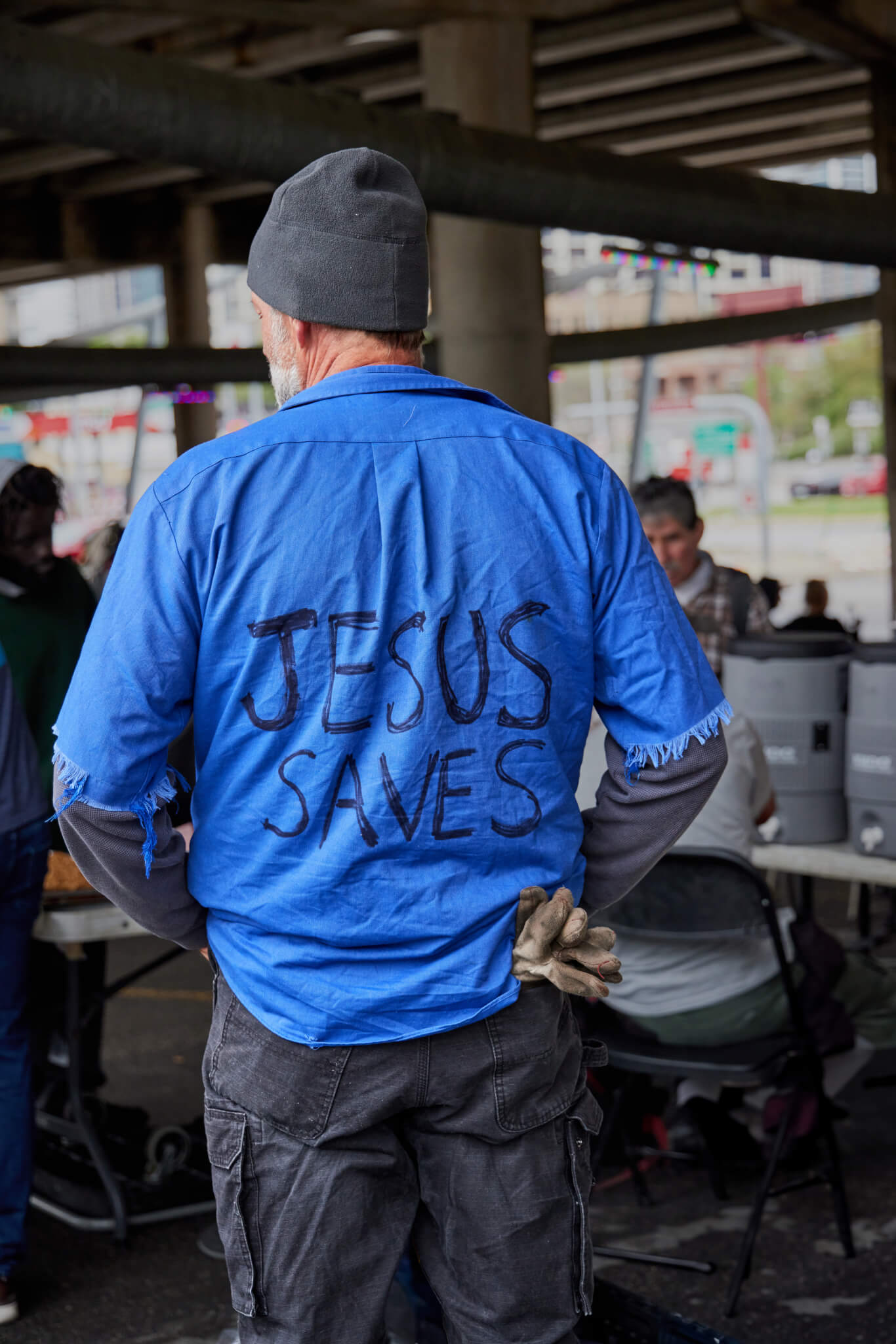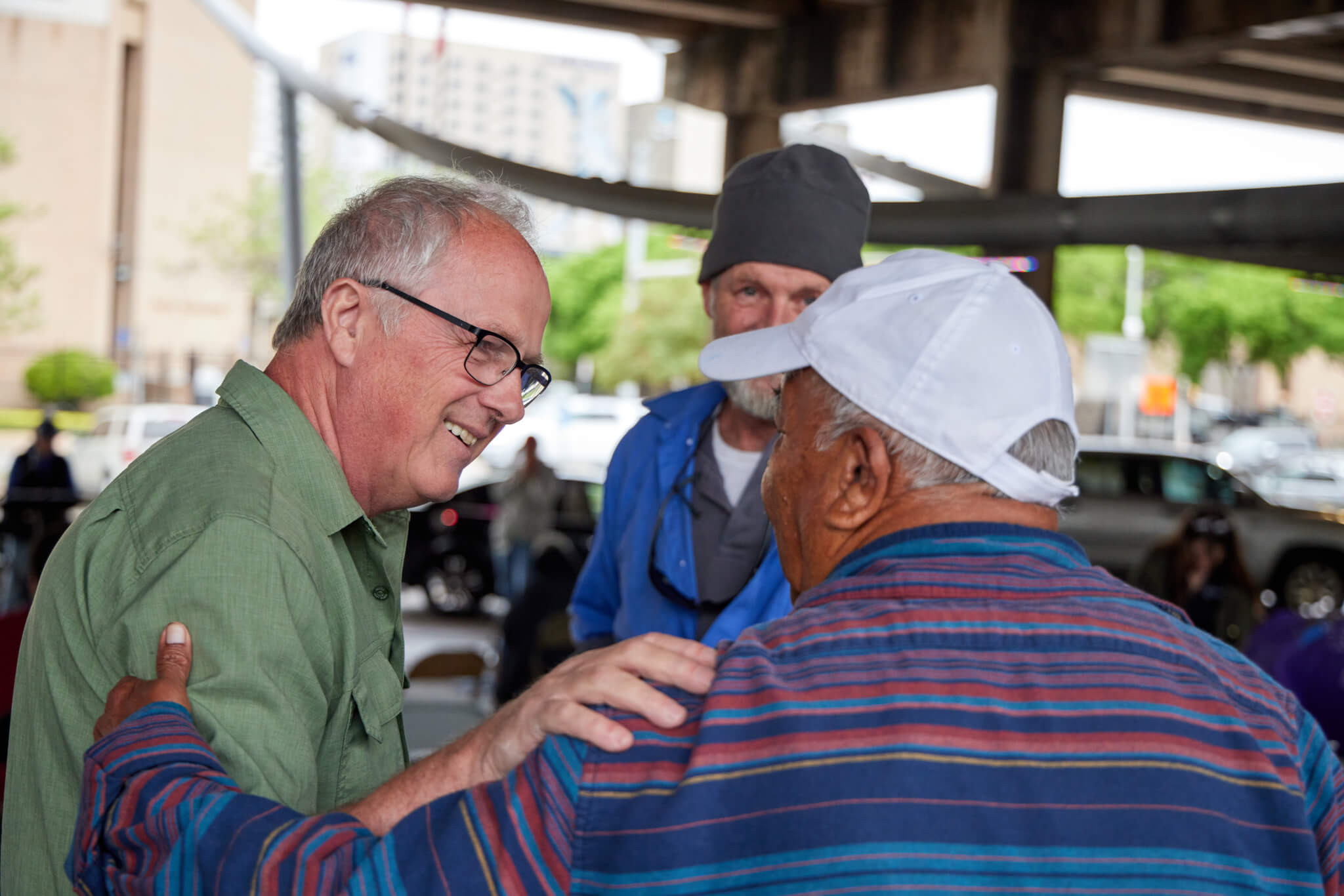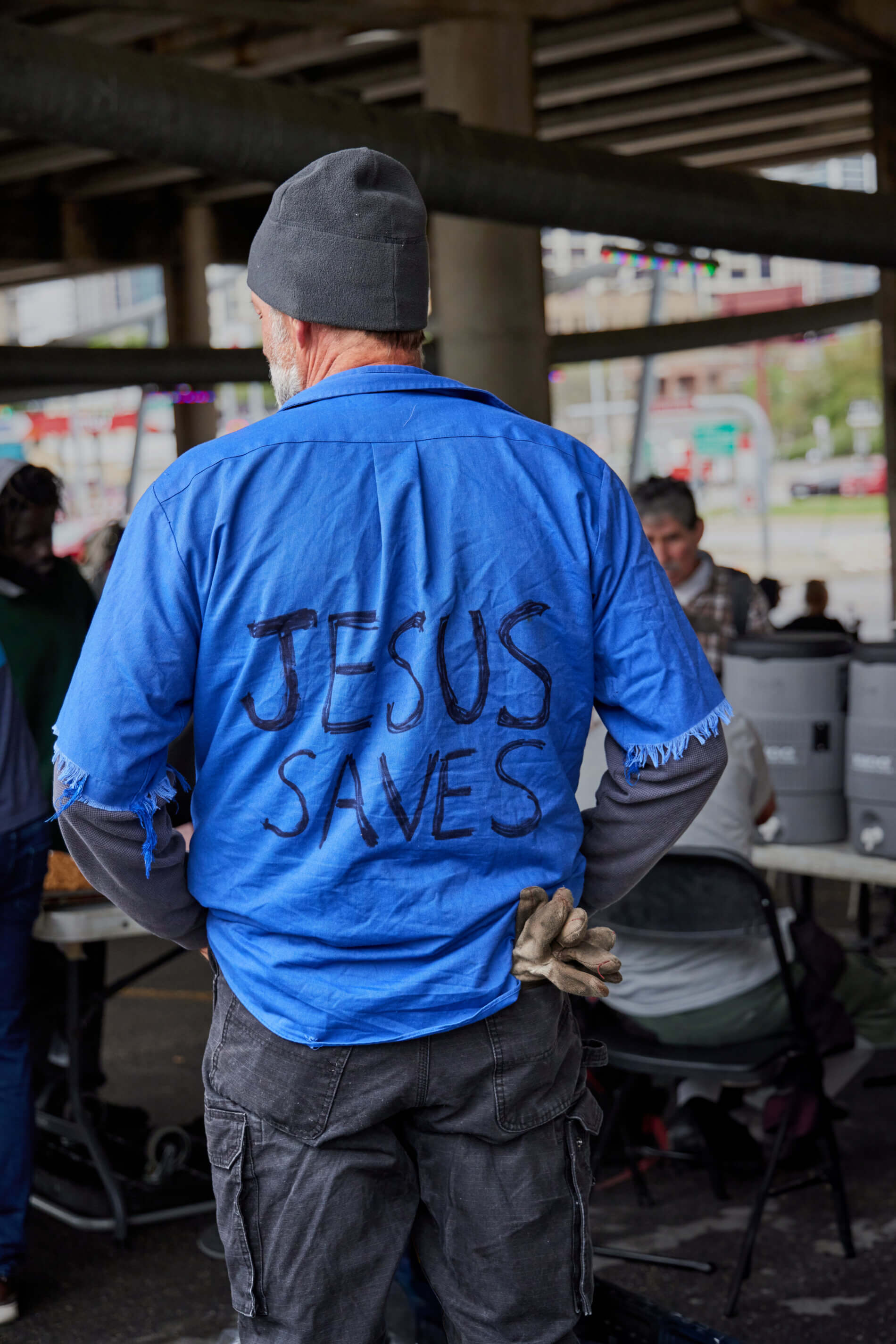
WORDS BY BETH AVILA | PHOTOS BY AMY MIKLER KENYON | VIDEO BY ALYSON AMESTOY
COMMUNITIES NEED HELP.
CAN CHURCHES BE THE
BRIDGE?
Amid the chaos of downtown Austin, faith communities work together on behalf of their neighbors experiencing homelessness.
Cars are flying past on the bridge overhead. People are shouting to each other. Cheers for early morning marathon runners can be heard from a street over. Traffic lights. Honking horns. Barking dogs.
Welcome to church.
This was my first experience with Church Under the Bridge (CUB), and it also happened to be the morning of the Ascension Seton Austin Marathon. Several downtown roads were shut down for runners, and the preacher was stuck in the mad traffic maze. Then the CUB supply truck stalled, and there were no empty parking spaces under I-35. It was not your average Sunday morning.
“We finally got there and unloaded all our stuff, then the musicians came, and then finally the food showed up. The preacher was late, so I had to preach, but we were so grateful to make it happen,” said Simon Kenyon, lead organizer for CUB Austin.
Started by Mission Possible Austin, a nonprofit organization working through collaborative efforts to minister to those living in under-resourced areas, CUB is a Sunday worship service helping to meet the spiritual needs of those experiencing homelessness in Austin.
This area of east downtown is what Christ Church Austin calls its parish—including with the city’s large population of neighbors experiencing homelessness who live there.
“Within a 500-foot radius around our church building, 70% of the homes are short term, rental homes,” said Matt Dampier, the rector of Christ Church. “So, our most permanent neighbors are actually chronically homeless folks.”
Every faith community has a unique body of neighbors with unique needs. Sometimes the biggest need of a local community is affordable childcare. Sometimes it’s mental health services. Sometimes it’s access to tutoring and further education. For the neighbors of Christ Church, the need was a spiritual gathering where they felt safe and seen.
Around 15 unhoused neighbors join on any given Sunday, and Christ Church welcomes these neighbors with open arms despite the challenges. “We believe that the Lord put us in this specific place,” explained Dampier, “and that the church is called to love God by loving those around them.”

Historically, that’s what the church has done. Sociologists such as Ram Cnann and Edward Newman have argued that the “social safety net” in the United States was to a large extent knitted together by faith communities. Vulnerable communities have long benefited from church-provided rental and food assistance, after-school care, mentoring of kids and single parents, and much more.
But are churches continuing to sustain that type of support? Respondents to the Foundation’s 2023 community survey are not so sure. Only 44% of participants said they feel their faith communities are doing enough to help locals in need, compared to 80% in 2019.
Local churches are and should always be an essential part of the solution for meeting local needs. Faith communities are called to step up and address the distinct problems in their neighborhoods. That’s why examples like Church Under the Bridge—sustained in part through a 12-year-old volunteer partnership with Christ Church Austin–are so vital.
Church Under the Bridge’s name is apt. Services take place each week under Interstate 35 between 7th and 8th Street. That is exactly where you’ll find Christ Church parishioner Simon Kenyon and his wife, Amy, every Sunday.
When the couple was fairly new to the Austin area, they heard about the volunteer opportunities CUB offered through a ministries night at Christ Church highlighting different opportunities to serve. “It sounded like something we could get involved in as a family,” said Kenyon. And what started out as setting up chairs, distributing food/coffee, and continuing to show up week after week led to Kenyon taking the lead organizing role for every Sunday.
The “social safety net” in the United States was to a large extent knit together by faith communities.
According to Kenyon, the power of CUB lies in its consistency. People experiencing homelessness all over Austin know that every Sunday the volunteers will be there, along with a series of partner organizations. Once a month, a reading glass business sets up near CUB and works with the unhoused who need reading glasses. Another group of students show up to perform health and wellness checks. Even the City of Austin is involved, providing numerous bus passes handed out by CUB volunteers.
“They know the people will be there at that given time,” explained Kenyon. “We had a guy with a ministry that finds jobs for people who have just come out of prison. He was driving past and saw the crowd, so he stopped and gave me his cards. He has relationships with people who are willing to offer employment, and I’ve already pointed three people in his direction.”
Kenyon also maintains that Church Under the Bridge is first and foremost a place of worship.
“I remember when we first started serving communion down there and initially volunteers were a little wary of doing something so sacred in that environment,” Kenyon said. “But we were amazed at the amount of respect the sacrament is given down there. For a few moments, you look around and think, ‘Wow. Real community and real worship are taking place right now.'”
Despite the challenges of its location, Kenyon has personally seen the effect on the surrounding homeless community.
“There was one lady who came and gave her testimony. She’d been a dealer on the street, and she got some bad dope and several people died or overdosed. She just got out of prison and asked if she could share. She took the microphone and said what she had done, and then she just asked for forgiveness from the community she had hurt. She testified about how God, despite what she had done, had forgiven her. It was absolutely incredible,” Kenyon shared.
In community service, you don’t always get to witness powerful scenes like that. The day to day may be a little messy and look more like Christ Church’s staff meeting about the best way to pick up syringes around the church property.
But as Rector Dampier says, “It’s a privilege … we get to have these conversations in our church and do this work in order to serve our neighbors.”

68% of survey respondents said supporting people living on the margins was a top priority for their faith communities.
Participants in our 2023 community survey from Austin gathered to discuss the pressing needs in their community.